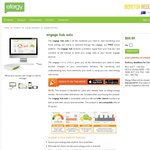If you already had a energy monitor installed as art of the governement scheme this is a nice little upgrade, add this to your interest with the iPhone or Android app you can track your power usage much more efficiently.
The Bargain is "Free Postage" during December (Saving $9.95)
Below is the websites information
engage hub solo
The engage hub solo is all the hardware you need to start monitoring your home energy use online in real-time through the engage, our FREE online platform. The engage hub recieves a wireless signal from your fuse box and connects to the internet to send your usage data to your secure engage account.
The engage online platform gives you all the information you need to make positive changes to your consumption behaiour. By monitoring and understanding how much electricity your home is using you can save energy and money.
NOTE: This product is intended for users who already have an efergy energy monitor. No transmitter and sensor are included when purchasing this product. The engage hub solo is compatible with your e2 and elite classic monitors as well as with their sensor and transmitter. This product is not compatible with an IR sensor.
engage online platform features
Access your energy data anytime, from anywhere
Eliminate bill shock, monitor your energy costs in real time
View your daily, weekley, monthly or average costs in easy-to-read graphics
Set your monthly budget and see how close you are to meeting it
Compare your energy over 12 months and see where your costs are highest
Choose to view your energy data in £'s, kWh or CO2
Discover and reduce your carbon footprint
Teach your family about energy use and saving
Use the engage hub solo kit to track reductions in your household energy
COMING SOON
Social Media widget - share your data with the online community
Energy Report - download your energy data onto your PC/Mac
Our engage hubs are simple to install and use. A small sensor is clipped on to the supply cables in your breaker panel. A lead from the sensor is connected to the efergy transmitter, which then wirelessly sends real time data to the home hub. The home hub is connected to your internet router via Ethernet cable. When you go online to our web portal or onto your smartphone app, the router wirelessly uploads your energy data and converts this data into kilo-watt hours. The web platform or app will then show you how much energy you are using in the same units that are on your bill. You can also see how much energy you are saving compared to other web platform users, compare energy saving tips, and set energy consumption targets.


Same prices a month ago, no bargain…
http://webcache.googleusercontent.com/search?q=cache:ePXkeXd…